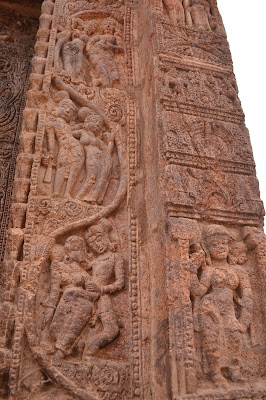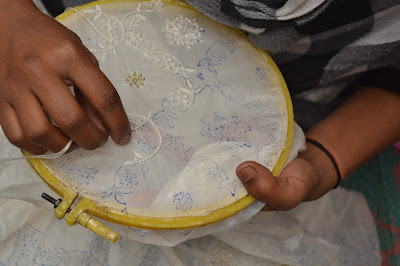KHADI-The Revolutionary Textile
Khadi,a word synonymous to one of
the strongest revolution in history, shaking the entire world with the power of
a mere textile -is an uprising for self dependence and glory, a tribute to the
oldest civilization of the world, a celebration of age old rituals and
tradition. The village which actively stood in unison to participate for the
cause was Srikakulam, a serene and calm coastal area of Andhra Pradesh which
has been abundantly blessed with all the richness of mother earth. The ecstasy
that engulfed us enroute Srikakulam was an outcome of the abundant beauty
surrounding us from the silent nagarveli river to the yellow carpet of corn
fields to the luscious palm and coconut trees sheltering the pebbled narrow lanes vanishing into the horizon.
"Andhra Fine Khadi", is
a prominent name all over India. This is because this variety of khadi is
produced from a special variety of cotton namely Punasa cotton, Hill/ white
cotton and Red cotton, of very short staple structure produced in Srikakulam
area. The cotton is combed and purified with the help of fish jaws which
renders it the exceptionally superfine finish that is not
lost even after the whole process of weaving.Normally
most cotton in India is machine carded, that means the fibers are combed and
mechanically separated from the seeds and rendered into fluffy bats for the
hand spinners.The entire process of manufacture — from the separation of the cotton
to the spinning, is done manually. The villagers take pride in their knowledge
that no advanced mechanised technology can replicate such finesse.
Change is the only constant in
this world- the phrase comes alive with the fact that the khadi version which
was a rave in yesteryear lost its charm with the changing times and required
the much needed transition to stay in vogue . When the weavers in Srikakulam
were busy fiddling with the same old designs on khadi resulting to a financial crisis
over its declining demand, Gaurang’s involvement proved to be a Midas touch for
the age old fabric. The subtle small geometric borders adorned with small butis
on Kora were replaced with bright floral jaals accentuated with animal motifs,
elaborate borders creating the magic of
jamdani on bright colored khadis like yellow, orange, red, purple,blue, beige
with multicolored threadwork and zari, surpassing people’s perception of a
khadi saree to an unimaginable extent offering them with a spoilt choice of the
contemporary versions.
The technicality : The secret behind the quality of
Gaurang’s extravagant khadis not only lies on the special weaving techniques he
incorporates but the entire process which begins with the healthy processing of
the cotton yarns.The yarns are dyed and washed and then soaked in a mixture of
rice starch and water for three days lending them the necessary sheen and
strength to undergo the processes following it.They are then beaten up to
remove superficial short fibers and winded up in bobbins(dabbal) using a Charkha. Multiple such bobbins then unwind in a
particular manner as per the design to form the warp(padagu) sheet in a big manually rotated motorized wheel(raate). While a normal khadi saree is of
42”-46” width using 2500-3500 yarns of 60s and 80s count, Gaurang’s Khadis have
a 50” width using upto 4000 yarns of 60s-100s count giving it the grander look
with fine quality and smoothness.The warp sheet then undergoes the process of
denting and drafting through the two heald shafts(atsul) and reed (palakka)
using the age old method of joining yarns using a particular knot(atsu).The warp sheet is then shedded
properly and attached to the loom(maggam)
winded up in the warp beam.The ancient technique of paper jamdani replicating
the interesting method of tapestry weaving is being implemented to brocade
Gaurang’s Khadi sarees creating only sheer magnificence.The time consuming
technique of paper jamdani is undergone using innumerable tillis(dindillu) for brocading in a single lift
to weave different colors and designs alongwith the base weft(peka). Gaurang’s khadis sometimes uses
20-25 colors in a single design involving the use of as many as 150 tillis in a
single lift giving us a clear idea of what it takes to create a masterpiece by
a skilled weaver .Hence the time taken is also from 4 months-8 months
unlike a few days required for a normal
khadi saree.The outcome can only be considered to be an awe inspiring tale of
craftsmanship, strong age-old heritage and classicism.
Apart from the paper jamdani technique
, another age old technique of hand dobby(Ada)is
incorporated sometimes to create beautiful geometric patterns with extra warp
brocading on borders. The temple borders of various dimensions are woven
alongwith the plain zari border to balance the intricate allover designs giving
us the flavor of trend and tradition together. The paithani designs are also
being created using paper jamdani on khadi which is throwing light into the
multifacetedness of khadi yarns which
was underused with minimalistic approach for a long time and has only been
endowed its richness now with Gaurang’s dramatic weaving amalgamations leaving
everyone spellbound. The process of 3 shuttle weaving technique for bringing
alive the possibilities of yarn combinations like muga with khadi, Muga with
silk is also being practiced, again creating an entirely different line of
khadis.
The weavers who were only weaving
basic khadi sarees with regular butis and borders are now strikingly bringing
into perfection the art of elaborate designs on khadi at par with a heavy
kanjeevaram sari or a grand Benarasi sari. The challenges thrown by Gaurang at a bunch of
almost 300 weavers in srikakulam spanning 10-15 villages, are always different and
tough but their zest to take them up is incredible and sometimes follow with a
rigorous training by the master weavers for tougher challenges. The true Indian
fabric which transformed millions of lives in a bygone era is again trying to
transform lives of many now, with efforts from textile reformist like Gaurang
and hence addressing more and more weavers to join this saga in an active way
making it their way of life as it was
once in history.































































